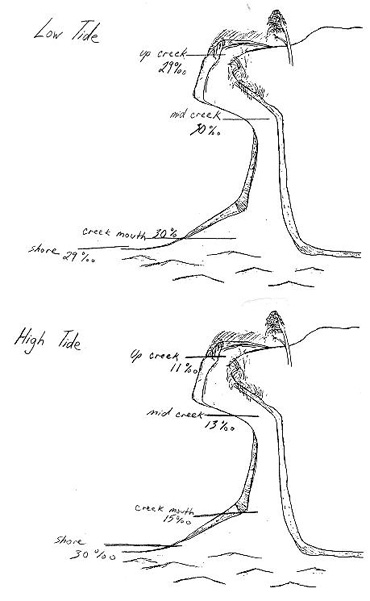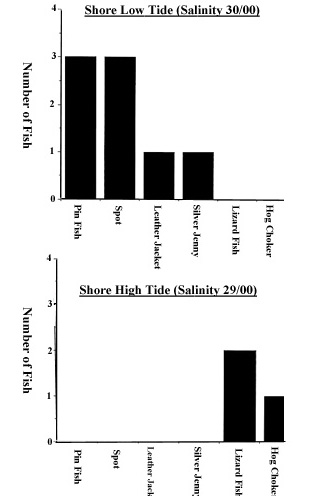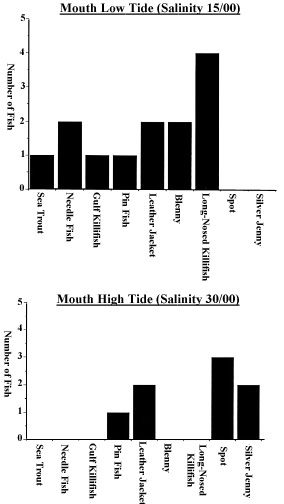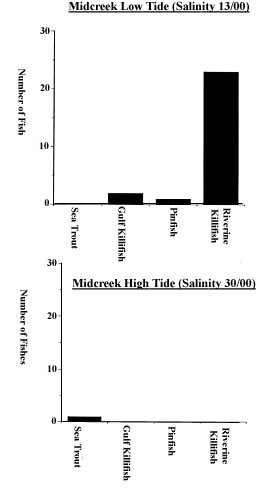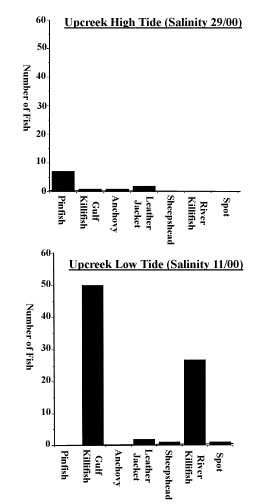



Brenna Gresko, Adrienne Kraft, Marcus Flippo,
Alexis Mitchell, Clinton Cunningham, Matt Lee,
Erin McCarthy, Amy Hinsley, Allison Schaffer
After exploring a tidal creek at Turkey Point Salt Marsh we began to realize how important the tide is to the fishes' environment. When we returned to the F.S.U. wet laboratory we created a list of possible questions to investigate. Some of the questions we considered were. . . What reasons do the fish have for swimming deeper into the tidal creek? What types of salt water fish prefer low salinity water? After careful deliberation we decided to study the question: Do the salinity and temperature changes that occur with the tide change the location of the fish in tidal creeks? By studying the salt water fish in the salt marsh near the F.S.U. laboratory we expected to find more salt water fish in the salt marsh during high tide than low tide.
This study is important because it shows how the tide changes the number of the fish and their location. If there is a change in the location of the fish in tidal creeks during the ebb and flow of the tides, development of the area would have an impact on the fish population. Changes might restrain the salt water fish from leaving the salt marsh or destroy their habitat.
The materials we used were seine nets (5 mm mesh size), buckets, and measuring tape. We also used a refractometer, an instrument used to measure the salinity of the water, thermometer, and survey tape.
First, we decided on the four sampling locations at Turkey Point Salt Marsh. The locations were chosen because each site was expected to have a different amount of salinity. Second, we gathered our materials and measured the salinity with the refractometer and took the water temperature with the thermometer at each location. Third, we seined at the four different places, the shore, the creek mouth, the middle creek, and the upper creek. We held the seine net at a forty-five degree angle and we walked slowly keeping the lead line low to the ground so the fish could not escape. We pulled the seine net a distance of fifteen meters at each station. We marked the start and finish of the sampling area with the survey tape so that we could find the sampling site again. Then we pulled the net up on the beach where the fish were counted and identified. After we recorded the fish in our notebook we put them in the buckets. Finally, when we were finished with each sample we released the fish.
Fish Salinity Tolerance
Mid Only: Needle fish, blenny, long nose killifish, sheepshead, riverine
killifish.
Mid-High: Pin fish, leather jacket, spot, sea trout, gulf killifish.
High Only: Lizard fish, hog choker, silver jenny, anchovy.
As graph one shows, both shore samples had similar salinities. There was quite a difference in the marine life that was found during high tide and low tide, but we observed that only high or mid to high salinity fishes were found near the shore.
As graph two shows, the salinity in the mouth samples were dramatically different. At low tide, the salinity was 15/00, as opposed to the high tide salinity of 30/00. At the mouth during low tide, we observed that there were only mid and mid-high salinity fishes. On the other hand, there were mostly mid-high salinity fishes (and one high) found during high tide.
Graph three shows us that the salinity in the midcreek samples also drastically differed. With a low tide salinity of 13/00, the only fish that we found were mid-high or mid salinity dwellers. During high tide (with a salinity of 30/00), the only fish found at all (a sea trout) was a mid-high salinity dweller.
Graph four shows that the salinity in the upcreek samples differed a lot. During low tide, the salinity was a mere 11/00. There mostly mid to mid-high salinity fishes were found. But with a high tide salinity of 29/00, all of the fishes found were either mid-high or high salinity dwellers.
Discussion
Restating our basic question, do the salinity and temperature changes that occur with the tides change the location of the fish in the tidal creeks? Our research found that fish do migrate with changing tide. Tidal creeks contain a freshwater-saltwater mix that varies with the tides. Different species of fish are specialized for different levels of salinity. Fish found in high salinity areas migrate into tidal creeks with high tide following the increasing salinity level. Fish that are regularly in the lower salinity areas of the tidal creek migrate farther up tidal creeks away from the approaching high salinity water and with the lower salinity water. Some species of fish seem to tolerate low, mid, and high salinity areas. Some factors beyond salinity that may influence the distribution of fish in tidal creeks are the availability of food and presence of predators.
Any good science considers the limitations of their study. What may have affected our results were that we changed nets in the middle of our experimentation. The nets were different in that one had a larger mesh than the other. This could have had an affect on the size fish we caught. We also may have gotten more accurate results if we sampled more and collected more data. A clearer plan would also have been useful. We found that one group sampled each area three times while the other group sampled only one time. This miscommunication demonstrates how clarifying a project design is a critical component of research. Also, our method for measuring salinity may not have been consistent. Samples of water were taken at different levels. Saltwater is denser than freshwater and therefore settles at a lower level than freshwater. If our salinity measurements were to be accurate we would need to measure at the same depth for each sample. Our reason for doing this project is we care.
Diagram and Graphs
